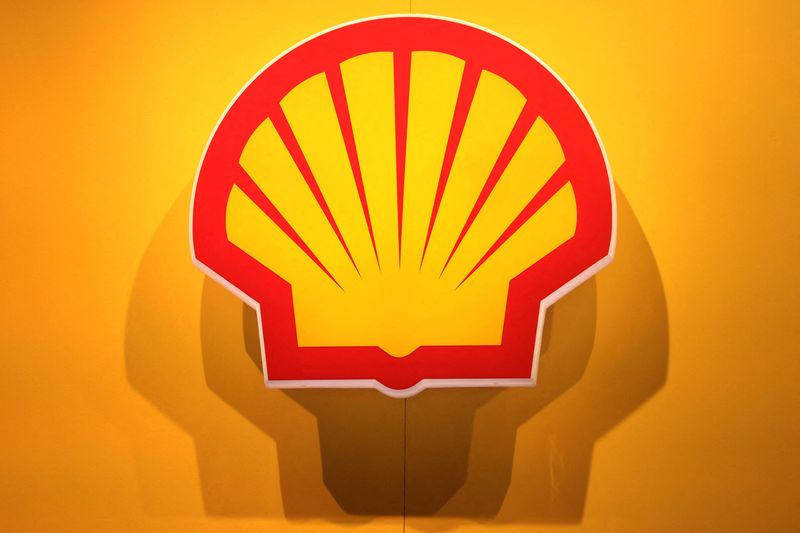Shell’s profits tumble 56% to $5 billion as energy prices cool By Reuters
[ad_1]

© Reuters. FILE PHOTO: The logo of British multinational oil and gas company Shell is displayed during the LNG 2023 energy trade show in Vancouver, British Columbia, Canada, July 12, 2023. REUTERS/Chris Helgren/file photo
By Ron Bousso and Shadia Nasralla
LONDON (Reuters) -Shell on Thursday reported a 56% fall in second-quarter profit to $5 billion as oil and gas prices and refining profit margins fell, prompting the energy giant to slow its share repurchase programme.
The earnings, which missed forecasts, follow bumper earnings in 2022 after energy prices surged in the wake of Russia’s invasion of Ukraine, but were in line with its second-quarter performance two years ago.
Shell (LON:) said it would repurchase $3 billion in shares over the next three months, down from $3.6 billion in the previous three, while raising its dividend to $0.33 per share as previously announced in June.
In June, Shell announced it would buy back at least $5 billion in shares in the second half of the year. On Thursday it said buybacks of at least $2.5 billion will be announced at its third-quarter results.
“We will continue to prioritise share buybacks, given the value that our shares represent,” Chief Executive Officer Wael Sawan said in a statement.
Shell’s adjusted earnings of $5.073 billion missed company-provided analyst forecasts of $5.8 billion.
The results compared with record quarterly earnings of $11.5 billion a year earlier and $9.65 billion in the first quarter of 2023.
In June, Sawan outlined plans to boost shareholder returns and improve performance, including by keeping oil output steady, growing output and slowing down investments in lower-return renewable energy.
Shell shares were down 1.7% by 0730 GMT, compared with a 1% decline for the broader European energy index.
“A fairly disappointing set of 2Q numbers” due to lower-than-expected earnings from the upstream and chemicals divisions as well as weaker third-quarter guidance, Jefferies analyst Giacomo Romeo wrote in a note.
French rival TotalEnergies and Norway’s Equinor reported a similar drop in profits.
WEAKER QUARTER
The lower results mainly reflected lower liquefied natural gas (LNG) trading results, lower oil and gas prices, lower refining margins, and lower sales volumes, compared with the previous quarter, Shell said.
Oil and gas prices soared last year in the wake of Russia’s invasion of Ukraine but energy prices have dropped sharply this year as fears of shortages have eased.
Benchmark prices averaged $80 a barrel in the second quarter of 2023, down from $110 a year earlier.
LNG prices dropped to $11.75 per million British thermal units (mmBtu) from around $33.
Shell, the world’s top LNG trader, said earnings from its flagship division halved from the previous quarter due to a weaker performance of its trading division.
Shell reduced its debt pile to $40.3 billion by the end of the second quarter, down from $44.2 billion three months earlier, cutting its debt-to-capital ratio, known as gearing, by one percentage point to 17%.
[ad_2]
Source link

© Reuters. FILE PHOTO: The logo of British multinational oil and gas company Shell is displayed during the LNG 2023 energy trade show in Vancouver, British Columbia, Canada, July 12, 2023. REUTERS/Chris Helgren/file photo
By Ron Bousso and Shadia Nasralla
LONDON (Reuters) -Shell on Thursday reported a 56% fall in second-quarter profit to $5 billion as oil and gas prices and refining profit margins fell, prompting the energy giant to slow its share repurchase programme.
The earnings, which missed forecasts, follow bumper earnings in 2022 after energy prices surged in the wake of Russia’s invasion of Ukraine, but were in line with its second-quarter performance two years ago.
Shell (LON:) said it would repurchase $3 billion in shares over the next three months, down from $3.6 billion in the previous three, while raising its dividend to $0.33 per share as previously announced in June.
In June, Shell announced it would buy back at least $5 billion in shares in the second half of the year. On Thursday it said buybacks of at least $2.5 billion will be announced at its third-quarter results.
“We will continue to prioritise share buybacks, given the value that our shares represent,” Chief Executive Officer Wael Sawan said in a statement.
Shell’s adjusted earnings of $5.073 billion missed company-provided analyst forecasts of $5.8 billion.
The results compared with record quarterly earnings of $11.5 billion a year earlier and $9.65 billion in the first quarter of 2023.
In June, Sawan outlined plans to boost shareholder returns and improve performance, including by keeping oil output steady, growing output and slowing down investments in lower-return renewable energy.
Shell shares were down 1.7% by 0730 GMT, compared with a 1% decline for the broader European energy index.
“A fairly disappointing set of 2Q numbers” due to lower-than-expected earnings from the upstream and chemicals divisions as well as weaker third-quarter guidance, Jefferies analyst Giacomo Romeo wrote in a note.
French rival TotalEnergies and Norway’s Equinor reported a similar drop in profits.
WEAKER QUARTER
The lower results mainly reflected lower liquefied natural gas (LNG) trading results, lower oil and gas prices, lower refining margins, and lower sales volumes, compared with the previous quarter, Shell said.
Oil and gas prices soared last year in the wake of Russia’s invasion of Ukraine but energy prices have dropped sharply this year as fears of shortages have eased.
Benchmark prices averaged $80 a barrel in the second quarter of 2023, down from $110 a year earlier.
LNG prices dropped to $11.75 per million British thermal units (mmBtu) from around $33.
Shell, the world’s top LNG trader, said earnings from its flagship division halved from the previous quarter due to a weaker performance of its trading division.
Shell reduced its debt pile to $40.3 billion by the end of the second quarter, down from $44.2 billion three months earlier, cutting its debt-to-capital ratio, known as gearing, by one percentage point to 17%.